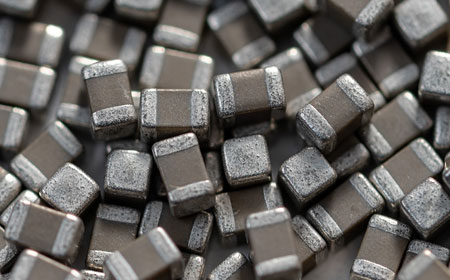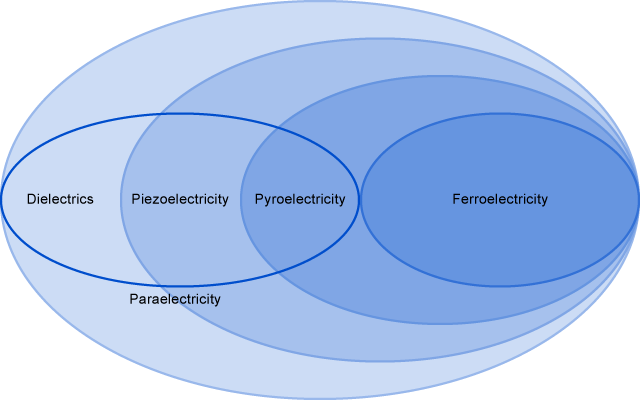Ferroelectrics are also attracting attention as high-performance ceramic capacitor materials. This section provides an overview of Ferroelectricity, its classification and applications.

What is Ferroelectricity?
Ferroelectrics are a type of insulator, or dielectric. There are four types of dielectrics
- Paraelectricity (Paraelectrics)
- Piezoelectricity (Piezoelectrics)
- Pyroelectricity (Pyroelectrics)
- Ferroelectricity (Ferroelectrics)
These four types do not each have different characteristics. Ferroelectricity is a type of Pyroelectricity, Pyroelectricity is a type of Piezoelectricity, and furthermore, Piezoelectricity is a type of Paraelectricity. This relationship is illustrated below.

When a voltage is applied to a dielectric, electricity does not flow, but is divided into two parts, one charged with positive electricity and the other with negative electricity. This is called polarization. In a paraelectric material, polarization disappears when the voltage is set to zero. Ferroelectric materials, on the other hand, remain polarized even when the voltage is reduced to zero.
Piezoelectric material is a substance that polarizes when deformed by applied pressure. Conversely, it has the property of deforming when voltage is applied. Pyroelectric materials are also materials that produce electrical potentials due to changes in temperature.
Normally, charged particles from the air are adsorbed on the surface to neutralize the charge, but heating causes an imbalance of charge with the valence particles on the surface, resulting in polarization. Pyroelectricity is also spontaneously polarized even when no voltage is applied, as is Ferroelectricity, but the direction of polarization cannot be changed.
Ferroelectricity is also characterized by Piezoelectricity and Pyroelectricity properties. Ferroelectrics therefore exhibit an electrical response to electricity and stress. In addition, some atomic configurations respond to magnetism.
Ferromagnetism (ferromagnet) exhibits similar behavior to ferroelectricity. Ferromagnetic materials form magnetic domains even when no magnetic field is applied. The use of the prefix Ferro for ferroelectricity is derived from this ferromagnetic material.
Potassium sodium tartrate (Rochelle salt) was once a common ferromagnetic material. In recent years, however, potassium dihydrogen phosphate (KDP) and barium titanate (BaTiO3) have been used as typical ferroelectrics.
Ferroelectricity Classification
Ferroelectricity undergoes a phase transition to Paraelectricity as temperature rises. Ferroelectricity can be classified into two types based on the difference in their phase transitions: "displacive" and "order-disorder" types.
• Displacive type
Displacive-type ferroelectrics do not undergo spontaneous polarization at high temperatures, as is the case with paraelectric materials. This is because at high temperatures they do not have permanent dipoles that spontaneously align.
However, at temperatures below the phase transition temperature (Tc), also known as the Curie temperature, the crystal becomes slightly elongated and positive and negative ions are displaced relatively, resulting in spontaneous polarization. Many ferroelectrics, including barium titanate (BaTiO3), are classified as displacive ferroelectrics.
• Order-disorder type
At high temperatures, the electric dipoles are randomly arranged, and they align as the temperature decreases, which is the order-disorder type. When the dipole orientations align and spontaneous polarization occurs, the material becomes ferroelectric.
Order-disorder ferroelectrics have zero polarization when viewed in the big picture as objects, because at high temperatures the electric dipoles are randomly oriented by thermal energy. Sodium nitrite (NaNO2) is a typical example of an order-disorder type.
Ferroelectricity Features
A characteristic of ferroelectrics is that they are spontaneously polarized even when no voltage is applied. Another feature is that the direction of polarization can be reversed by applying a voltage in the direction opposite to that of the poles.
Ferroelectric polarization is caused by an electrical imbalance due to distortion of the material crystal lattice. This is because the applied voltage changes the direction of strain as shown in the figure below, which also changes the direction of polarization.
Ferroelectrics are also characterized by hysteresis loops in the electric field and polarization curves similar to those of ferromagnetic materials.
Ferroelectricity Applications
Ferroelectrics are used as dielectrics in ceramic capacitors and PTC thermistors. As mentioned above, it is also a type of piezoelectric element and has a piezoelectric effect, so it is used as an ignition device and piezoelectric actuator.
One way to take advantage of the unique characteristics of ferroelectrics is to use them as nonvolatile memory materials. For this reason, SBT and PLZT are also utilized in ferroelectric memory and FFRAM (Ferroelectric Floating Gate Random Access Memory).
Reference (Japanese site)
-
富山大学 基礎物性工学研究室 「強誘電体とは」
http://piezo.eng.u-toyama.ac.jp/research/ferroelectrics/ferroelectrics-whatis -
はじめよう固体の科学 「常誘電体、強誘電体、圧電体、焦電体...:様々な誘電体とその特徴」
https://solid-mater.com/entry/diele#絶縁体と誘電体 -
電気通信大学 「謎に包まれていた次世代デバイス材料の強誘電性発現メカニズムを解明へ」
http://mx-backup.uec.ac.jp/research/information/column/17/index.html -
鉱物学雑誌 第14巻 特別号第2号 297~303 1980年3月 「強誘電体」
https://www.jstage.jst.go.jp/article/gkk1952/14/Special2/14_Special2_297/_pdf/-char/ja



